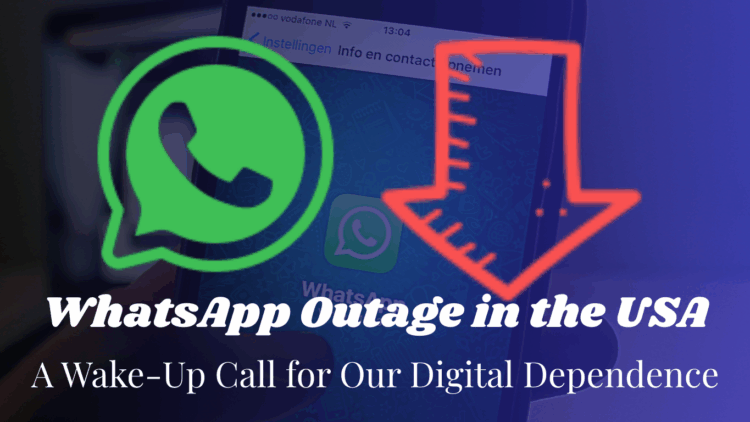On February 28, 2025, millions of users across the United States faced an unexpected communication breakdown—WhatsApp stopped working. From New York to Los Angeles, both individuals and businesses encountered sudden disconnection. It was more than just a technical glitch—it disrupted conversations, paused collaborations, and reminded us just how dependent we’ve become on a single app.
This wasn’t merely an inconvenience—it was a digital wake-up call. Let’s dive into what happened, why it matters, and what we can learn from it moving forward.
🚨 The Outage: What Happened?
The disruption began late morning around 11:00 AM Eastern Time, when users noticed their messages weren’t sending or receiving. WhatsApp Web went offline, media wouldn’t load, and users saw the dreaded “Connecting…” status on their apps.
Reports surged across DownDetector, and soon it became clear—this wasn’t an isolated incident. It was a nationwide outage.
By early afternoon, Meta had restored services, but the silence around the cause left users concerned and curious.
📉 More Than Just WhatsApp: Meta’s Entire Ecosystem Affected
Interestingly, it wasn’t just WhatsApp that was hit. Facebook Messenger and Instagram Direct, both owned by Meta, also experienced slowdowns and minor disruptions during the same period.
The simultaneous glitches across multiple platforms pointed to a broader infrastructure issue within Meta’s systems rather than a simple bug in the app.
🔧 What Could Have Caused It?
Meta didn’t release detailed information about the outage, but based on expert insights and past incidents, the following are likely suspects:
- Server Misconfigurations – A backend update gone wrong could easily throw a wrench into global services.
- DNS or BGP Failures – Network routing issues can disconnect entire systems from users.
- Cloud Deployment Bugs – Automated updates in large-scale cloud environments sometimes cause instability.
- Cybersecurity Events – While there’s no proof of hacking in this case, coordinated attacks like DDoS can temporarily knock services offline.
Until Meta offers a clear post-mortem, we can only speculate based on patterns from previous outages.
📲 Users Turned to X (Twitter) for Real-Time Clarity
When WhatsApp failed, users naturally rushed to X (formerly Twitter) to figure out what was going on. In no time, hashtags like #WhatsAppDown and #MetaCrashed were trending.
From frustration to funny memes, social media became the go-to outlet for expression, updates, and jokes. It once again highlighted the human tendency to seek clarity and community during digital chaos.
🤳 A Glimpse at Our Digital Reliance
This outage proved that WhatsApp is no longer just a chat app. It’s deeply woven into:
- Customer service and business communication
- Remote team management
- Online orders and delivery updates
- Doctor appointments and telehealth
- Virtual classrooms and education
When a tool this vital suddenly stops working, the impact is instant and wide-ranging.
💡 Business Lessons: Don’t Put All Your Eggs in One App
Whether you’re running a startup or a large company, relying on a single platform like WhatsApp is risky. Here’s what smart businesses should do:
- Diversify Communication Channels
Integrate backup tools like Telegram, Slack, Signal, or even SMS and email.
- Adopt Omnichannel Messaging
Tools that manage all customer communications across platforms can keep your service going even when one goes down.
- Educate Your Team
Train your team to switch tools quickly when disruptions happen.
- Use Monitoring Tools
Services like UptimeRobot or StatusCake can alert you in real time if a platform faces issues.
- Prepare a Backup Plan
Set up a predefined protocol: if WhatsApp is down, shift to another platform seamlessly.
🔐 What About Data Privacy?
One common concern during outages is data security. Fortunately, WhatsApp’s end-to-end encryption means your chats remain safe and unreadable to anyone—even Meta.
Still, during connectivity issues, syncing delays might occur. To protect your info:
- Back up chats regularly
- Avoid sending sensitive data during outages
- Don’t log out of the app unless advised
🛠 Meta’s Swift Response—and What’s Still Missing
Meta quickly acknowledged the problem and worked to restore services, which was appreciated by many. However, they still haven’t shared any detailed explanation, leaving users with unanswered questions.
Going forward, we hope Meta will:
- Invest in stronger infrastructure resilience
- Improve transparency during outages
- Enhance failover systems to avoid full-scale service interruptions
- Offer more detailed reporting to build user trust
🙋♂️ Tips for Everyday Users
You don’t have to be a business owner to be affected by these outages. Here are simple ways anyone can stay prepared:
- Keep alternative apps handy for messaging
- Avoid relying solely on one platform
- Use downtime productively—step away from the screen, connect offline, or catch up on other tasks
- Stay updated via reliable sources, like status pages or trusted tech news
✍️ Final Thoughts from Jayanta Tewari
Here at Jayanta Tewari, the official website of Bongsky Private Limited, we understand the weight that technology carries in today’s fast-paced world. One outage can stall a business, disconnect a team, or delay important conversations.
That’s why we believe in future-ready digital strategies. From communication redundancy to platform diversification, being prepared isn’t just smart—it’s essential.
If your business depends on apps like WhatsApp, it’s time to think beyond them. Let’s build digital systems that stay strong even when the giants fall.







